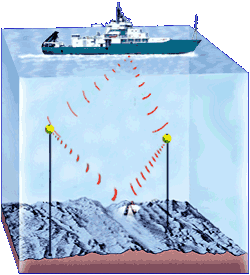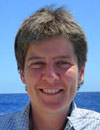|
  Today's Weather Partly cloudy Lat: 04° 11’S Long: 14° 48’W Air Temp: 77.5°F Bar Pressure: 1012.1 mbar Sea Temp: 79.6°F Sea State: 4 to 6 feet Swell: less than 7 feet, ESE Wind: SE; 11 to16 knots Visibility: Unlimited January 5, 2008 (posted January 6, 2008) by Susan Humphris, edited by Kristen Kusek Today feels like New Year’s Eve all over again. Everyone keeps checking his or her watch, knowing that tomorrow morning at 0200 hours in ship’s time (2 a.m.), we will finally arrive at the location we want to explore, after six days of transit and more than 1,300 nautical miles (almost 1,500 statute miles) from our start in Natal, Brazil. It’s hard to wait for the real fun to begin. It almost seems as if our autonomous underwater vehicles (AUVs), Puma and Jaguar, are getting bored and want to break out of the hangar and plunge into the ocean. For several days now, they have been all dressed up, but with nowhere to go—running their motors and propellers and going through this test and that one, but stuck within the confines of the ship. Not for long! Meanwhile, just after lunch, our team of engineers began a “code freeze.” Obviously this kind of “freeze” has nothing to do with our 80°F weather. Instead, it’s computer lingo. Since leaving Natal, engineers and students have been tapping away feverishly on their computers, developing and tweaking computer code, organizing data pathways, and making sure communications channels between Puma, Jaguar, and the ship are working. Engineers never stop thinking of new ways to do things, so they are constantly developing nifty, new features to make the AUV operations even smoother. While some of this work has been coordinated, other parts have been done independently, so now it’s time to test all of the systems together at once. That’s where the “code freeze” comes in: Everyone has to stop making any more changes to the computer codes so that we can test them at the same time. Of course, we’ve already run millions of tests. “The vehicles have been being tested since we began our transit, and even before that,” explained graduate student Clay Kunz. “But as we keep making changes to our computer codes, our tests become less valid. We need to stop changing things, and now make sure everyone’s work is in sync.” If the tests after the “code freeze” reveal that there are problems that have to be fixed in the software, we will have time to do so before the AUVs take to the water. However, once all seems to be running smoothly, we will back up the system and save the data, and this will be the system we refer to for operations. Sometimes making all these changes to the software gets confusing, so we have to be super well organized. Software engineers use something called a “version control system” that keeps track of all the changes that are made. That means if you want to go back to the version of the computer code that you were using last Tuesday, for example, the system can resurrect it for you. Now the countdown begins! We will soon be “on station” at our study site at 4°S on the Mid-Atlantic ridge As if we haven’t made them wait long enough, Puma and Jaguar will have to be patient. Before we can dunk the “cats” for their first real expedition, our first task will be to carry out a multibeam survey so we have a bathymetric map Read the new interview
[ Previous day ] [ Next day ]
|
||
Mailing List | Feedback | Glossary | For Teachers | About Us | Contact
© 2010 Dive and Discover™. Dive and Discover™ is a registered trademark of Woods
Hole Oceanographic Institution



